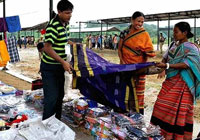
The experiment with border haats
Syed jamaluddin | Wednesday, 23 September 2015

People are curious about border haats. They want to know how these haats operate. Haats sit once a week for a short time. People can walk in within five miles of the border with identity cards. Only 25 listed businessmen from one country can sell their products. One can not buy products worth more than US$100. Only locally produced items are brought in the market. Prices are generally low. As these products are easily available, these no longer attract buyers. Businessmen of both countries are frustrated. In many haats, Bangladeshi shops are without customers. The objectives of setting up these haats have not been fulfilled.
Experts feel that all kinds of commodities need to be traded in order to make the haats successful. The number of listed businessmen need to be increased. In case of valuable products, duty may be reduced by 50 per cent. The haats began with the aim of improving living standards of the people on both sides. But this purpose has not been fulfilled. People come to these haats to meet friends and relatives in a relaxed mood.
At present four border haats are in operation between Bangladesh and India. These are Kurigram, Sunamganj, Feni and Brahmanbaria. The border haats started in 2011with the purpose of allowing people to trade in goods without passport and visa. India first proposed to set up such haats in 2005. Bangladesh at that time requested India to send a concept paper. In 2007 India sent a concept paper with all details. Implementation started after three years.
Bangladesh has proposed to set up another 14 border haats in eight districts. In 2013, India submitted proposals to set up 22 haats in Meghalay border. It is learnt from commerce ministry that efforts are being made to establish 21 border haats. Those haats will be developed in those places where there is no haat/bazaar. There is demand from both sides to increase varieties of products as well as number of businessmen.
As per agreement, ordinary products are traded in these haats. Businessmen from Bangladesh sell chanachur, chips, potato, eggs, soap, vegetables, tableware, chicken, readymade garments and household items. Indians sell fruits, vegetables, spices, turmeric, betel nuts, potato, honey and bamboo.
Border haat at Kurigram is not gathering momentum. Buyers and sellers are not coming here in big numbers. Restrictions on trading of goods are discouraging the businessmen who can not purchase/sell goods of their choice. According to the memorandum of understanding (MoU), 47 products of both countries are eligible for trading. The Indians are disappointed for not being able to buy Bangladeshi goods due to complexities. Bangladeshi products are not available in the market. This market is now closed due to floods.
Local representatives are of the view that not only local products but all products made in Bangladesh should be available for sale in the market. Although the Indians are showing interest to buy readymade garments and plastic goods, permission is not available to send those goods to India.
Brahmanbaria border haat started with the objective of building a bridge of friendship between the citizens of the two countries. Apart from buying and selling of goods, this haat has created an environment of mutual cooperation. People show enthusiasm about this haat. The haat starts at 10am and continues up to 4-00 pm. The foundation of this haat was laid on 21st May 21, 2014. Activities started on11th June 11 of the current year. Bangladesh's 69.66 decimals and India's 69 decimals of land constitute the area of the haat. Bangladesh spent Tk 20.44 million (Tk 2 crore 44 lakh) for this purpose. Indian contribution is not known.
Bangladesh's 15 products and India's 16 products are traded in this haat. Bangladesh products include biscuits, lungi, fruits and cottage industry products. India's products include vegetables, spices, tea, aluminium products, forest and cottage products. Fifty approved businessmen from both sides can undertake trading in the haat. Both countries are expected to gain from this trade. Local residents feel that the number of products must be increased. It will take time to develop the system. Nothing happens overnight.
Fashionable people come to Feni haat to meet friends and relatives. India has spent Tk 20.60 million (Tk 2crore 60 lakh) to set up 50 shops (tin sheds).These shops are equally divided between the two countries. Every Tuesday the haat starts at the mid-day and continues up to the evening. One person can buy goods worth US$ 100. Milk, chocolate, cosmetics, utensils, horlicks, soap, shampoo and tea leaves are sold from the Indian side. There is no retail sale. On Bangladesh side, there is notification that banned items can not be sold. Most of the buyers buy Indian goods and go home. In the Indian side, locally produced goods are not seen. On Bangladesh side, sea fish, hilsa, kai, dry fish and bakery biscuits are sold. Indian shops are crowded whereas Bangladeshi shops are empty.
Indian BSF check the goods when the buyers go out. Indian citizens hardly buy Bangladeshi goods. Money changers say that goods worth Tk Tk 10,000,00/12,000,00 (10/12 lakhs) are exchanged. BGB staff say that buyers are not harassed.
It appears that border haats are not doing well. Yet Bangladesh has asked for opening of more of these. The rationale of this approach is not clear.
The writer is an economist and columnist.
[email protected]